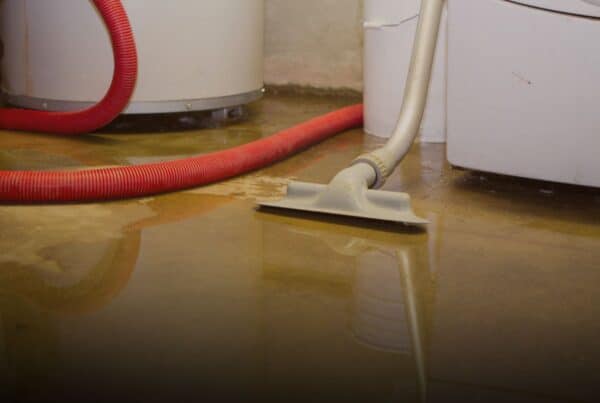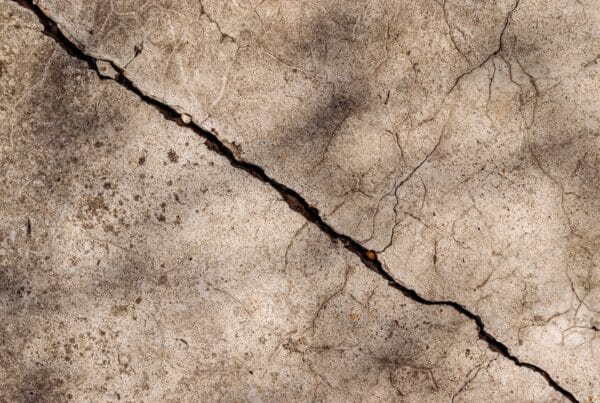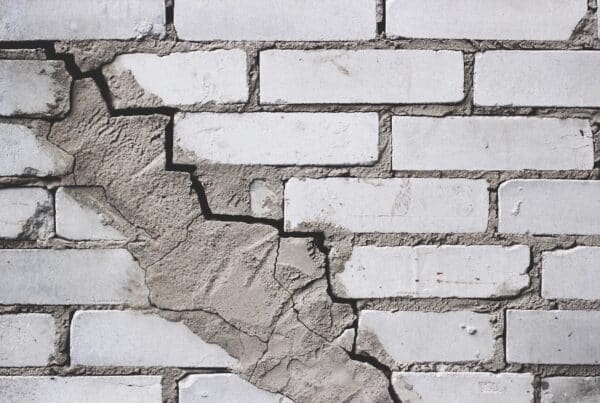If you have a retaining wall on your property, you’ve probably counted on it without giving it much thought until something seems off. Maybe it’s leaning a little, or cracking, or letting water through when it rains. Now you’re left asking whether you can fix something like this, or if the retaining wall is too far gone.
We’ll guide you through telling the difference so you know what to do next and when to take action.
What a Retaining Wall Is Meant to Do
A retaining wall’s job is to hold soil in place, especially when there’s a slope or change in elevation. Without it, rainwater could wash the soil downhill, leading to erosion, uneven ground, or even damage to nearby patios, driveways, or sidewalks.
These walls also help guide water away from your home. That’s a big deal in places like Ohio, where heavy clay soils can trap moisture and push against foundations. A working retaining wall helps relieve that pressure by managing runoff and directing it safely away.
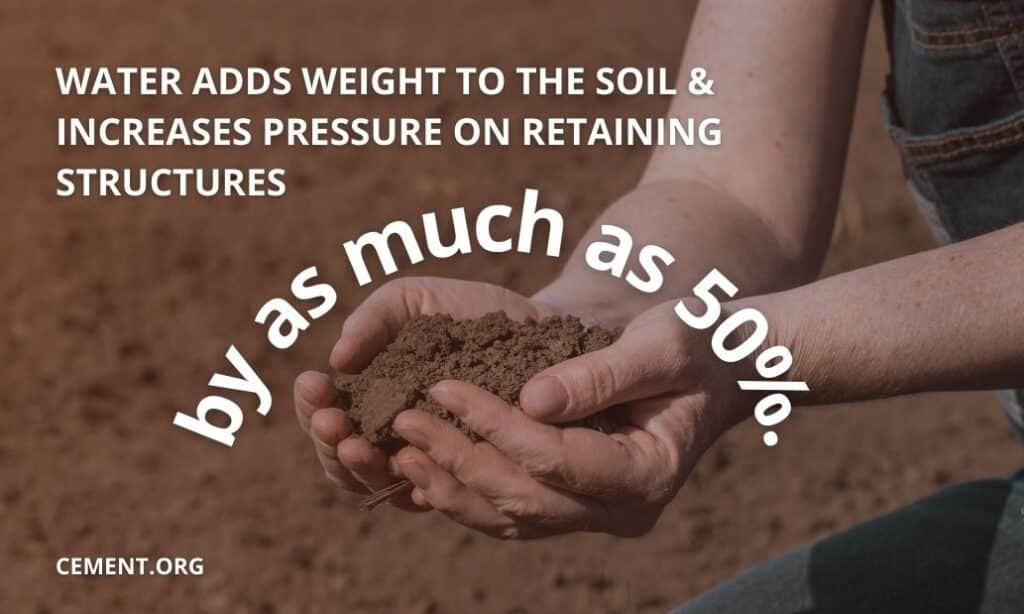
Signs There’s Something Wrong
Most retaining wall problems don’t happen overnight. They usually start small, and if you know what to look for, you can catch trouble before it turns into something more serious.
Cracks in the wall might seem harmless at first, but they’re often a sign that pressure is building up behind the wall. These grow wider as soil shifts or water collects, putting more stress on the structure.
Leaning or bowing means the wall is starting to lose its grip. This usually happens when the soil behind it is too heavy, wet, or poorly supported. A wall that tilts even slightly can become unstable fast—especially if it’s older or wasn’t built with proper drainage.
Water leaking through the wall or pooling around its base is another red flag. Retaining walls need proper drainage systems behind them, like gravel and drainpipes, to handle water runoff. Without it, water builds up and pushes against the wall, eventually weakening it.
Soil or gravel washing out from behind the wall can indicate that the backfill has eroded. That’s not just a cosmetic issue—it often means water is flowing where it shouldn’t, possibly undermining the wall’s base and causing it to shift or settle unevenly.
Poor drainage and unstable soil are the two most common reasons retaining walls fail, according to guidance from civil engineering sources like the Federal Highway Administration.
Can You Fix a Retaining Wall? Repairs That Usually Work
Not every problem means your wall needs to be torn down. In many cases, repairs can keep it going—if you catch the damage early enough. Here are a few examples of issues that are often fixable:
- Small cracks can usually be sealed with concrete filler or masonry caulk. They’re often caused by slight shifts in the soil or natural settling. As long as they’re not widening, this type of repair is simple and affordable.
- Slight leaning doesn’t always mean failure. Reinforcement systems like tiebacks or helical anchors can sometimes pull the wall back into position and stabilize it. These fixes are most effective when the lean is still minor and the wall hasn’t started falling apart.
- Drainage issues are a common cause of wall damage—and a common fix. Adding drainage gravel, installing a French drain, or adjusting the slope behind the wall can relieve pressure and stop water from building up. According to InterNACHI, poor drainage is a leading cause of retaining wall failure. Fixing the water flow behind your wall is often a critical step.
- Isolated block or timber damage can be repaired by replacing just the broken pieces. This works well for modular concrete walls or wood walls where the rest of the structure is still solid.
These kinds of repairs are often faster and cheaper than starting over—but they only work if the wall is still structurally sound and the root cause of the issue gets handled.
When It’s Safer (and Smarter) to Replace the Wall
Sometimes repairs just aren’t enough. If your wall has been failing for a while or the damage is widespread, replacement may be the only real solution.
Some signs it’s time to consider starting fresh:
- The wall is leaning too far and can’t be pulled back into place. A small tilt can often be corrected, but a wall that’s heavily leaning or bulging is likely too unstable to save.
- Large cracks are spreading or running deep through the structure. Cracks that run across multiple sections or reach all the way through the wall usually mean there’s serious stress behind it that patching won’t fix.
- The base or footing is failing. If the wall’s foundation has shifted, eroded, or settled unevenly, the structure above it won’t hold up. In this case, rebuilding is usually the safest and most effective option.
- You’ve made multiple repairs, but the problems keep coming back. When a wall has already been patched several times and still shows new signs of damage, it’s a good sign that repair alone won’t solve the real issue.
Replacing a wall costs more upfront than patching it, but it often saves money in the long run. A new wall built with proper drainage, stable soil support, and updated materials is less likely to fail again.
How Drainage and Soil Conditions Affect the Outcome
If water can’t drain away properly, it builds up behind the wall. This added pressure—called hydrostatic pressure—pushes against the structure every time it rains. Over time, that pressure can cause cracking, leaning, or total collapse.
Soil type also matters. Much of the soil in and around Columbus is soil-heavy, which expands when wet and shrinks when dry. Expansive soils can cause several inches of movement in foundations and retaining walls.
That constant shift adds stress behind the wall and can lead to movement or instability. If the wall was built without considering this, it’s more likely to fail.
Fixing or replacing a wall without solving these issues means the problems will just return. That’s why drainage upgrades and proper backfill matter just as much as the wall itself.
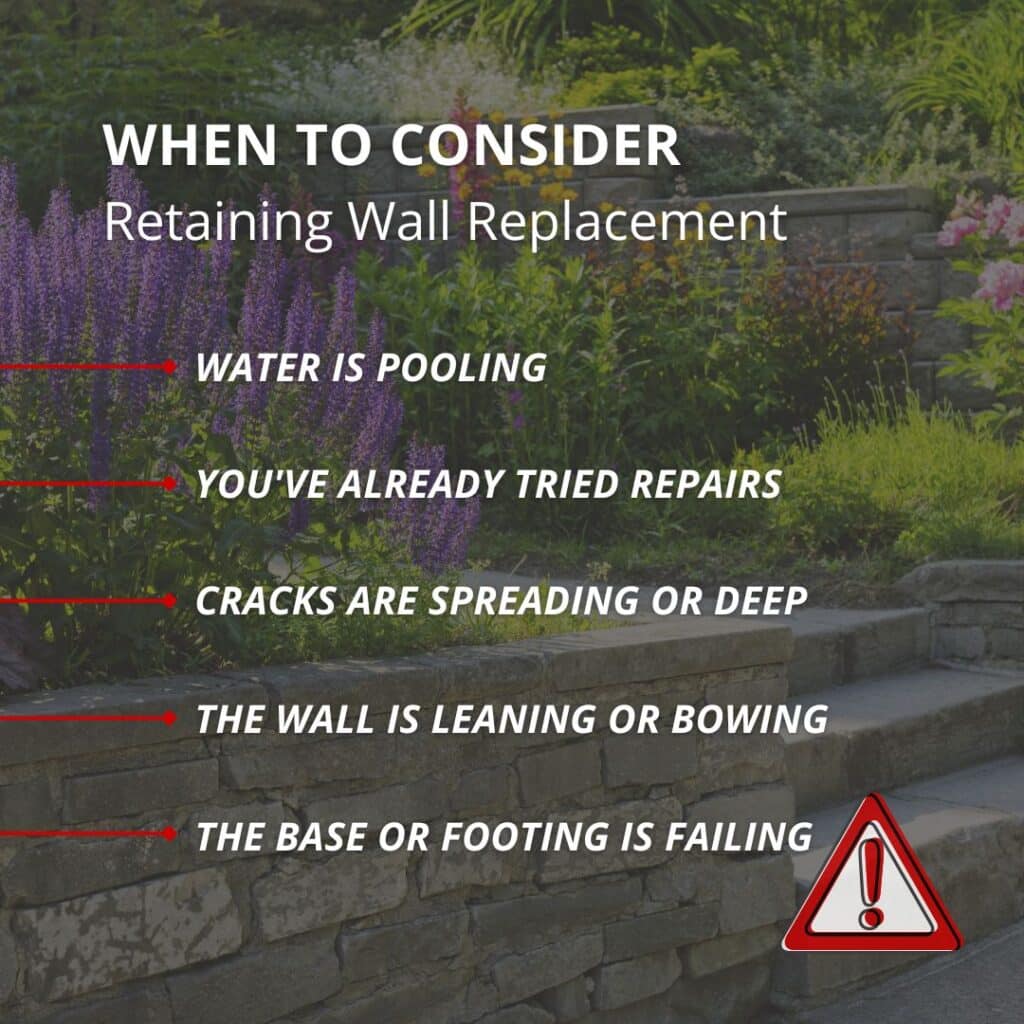
Other Recommended Maintenance
- Once your retaining wall is in good shape, here’s how you can keep it that way. Clear away leaves, dirt, and debris from weep holes and drainage paths
- Check the wall after big storms for cracks, bulges, or pooled water
- Watch for soil erosion or gravel washing out from behind the wall
- Keep the slope behind the wall graded so water flows away, not toward it
Even a quick visual check a few times a year can help you spot small problems and extend the structure’s lifespan.
When to Call a Professional
If something looks off—or you’re just not sure what you’re dealing with—it’s a good idea to get an expert involved.
Call a professional if:
- The wall is leaning or bowing noticeably
- Cracks are spreading or deep
- Water is constantly pooling behind or around the wall
- You’ve already tried repairs, but the problem keeps coming back
These issues often point to deeper problems with drainage, soil movement, or structural stability, and a qualified professional will know how to assess what’s going on to recommend the safest, most cost-effective next steps.
Conclusion
You don’t always need to replace a retaining wall when something goes wrong—but some problems are too serious for a quick fix. Watching for things like leaning, cracking, or poor drainage, helps you make smart choices before the damage worsens.
If you’re unsure whether your retaining wall can be fixed or needs replacement, getting professional advice from Buckeye Basement Solutions is a smart first step to protecting your home and yard long-term.

